In this comprehensive guide, we will delve into a range of different succulent types that not only stand out but are also a delight to cultivate.
Aloe Vera (Aloe barbadensis)

Aloe Vera is perhaps one of the most recognized succulents in the world, famed for its medicinal properties as much as for its beauty. Originating from the Arabian Peninsula, this succulent thrives in warm, dry climates. What makes Aloe Vera unique is its thick, fleshy leaves that are usually serrated along the edges. The leaves contain a clear gel that is often used in skincare products, touted for its soothing and hydrating properties.
In addition to its beauty and practical applications, Aloe Vera is incredibly easy to care for. It prefers bright, indirect sunlight, and watering should be infrequent—allowing the soil to dry out completely between waterings. This resilience makes it an ideal choice for beginners and seasoned plant enthusiasts alike. Aloe Vera represents more than just a houseplant; it’s a symbol of wellness and natural healing.
Burro’s Tail (Sedum morganianum)

Burro’s Tail, or Sedum morganianum, is a charming trailing succulent that boasts long, cascading stems adorned with plump, blue-green leaves. Native to Mexico, this succulent has gained a reputation for being a stunning addition to hanging planters and shelves. Its trailing growth habit gives it a unique drapery, reminiscent of a lush green waterfall.
One of the fascinating traits of Burro’s Tail is its resilience; it can grow in various light conditions, although it flourishes best in bright indirect sunlight. When it comes to watering, this succulent is typical of its kind—allow the soil to dry out completely before soaking it again. However, it’s essential to handle the leaves with care, as they are incredibly fragile and can drop easily if mishandled. This characteristic serves as a gentle reminder of nature’s delicate beauty.
Flaming Katy (Kalanchoe blossfeldiana)
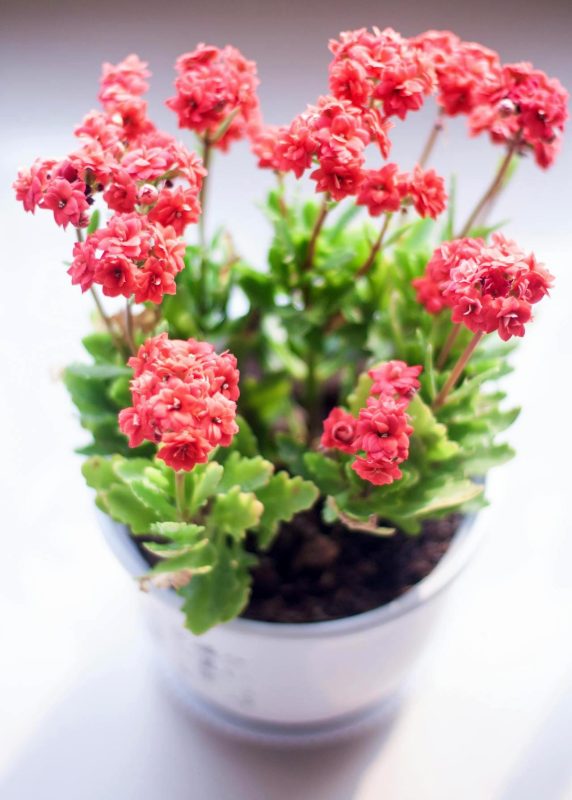
Flaming Katy, widely known as Kalanchoe blossfeldiana, is a compact succulent renowned for its vibrant flowers. Native to Madagascar, this succulent produces clusters of blossoms in colors ranging from pink to red, yellow, and white, making it an eye-catching addition to any garden or indoor space. It typically blooms in late winter to early spring, providing a burst of color during the months when most plants lie dormant.
Maintaining Flaming Katy is relatively straightforward, requiring bright light to encourage blooming. The plant prefers to dry out between waterings, similar to most succulents, but it’s crucial to monitor it, as overwatering can lead to root rot. Beyond its ornamental appeal, Flaming Katy is often seen as a symbol of prosperity and joy, making it a thoughtful gift for loved ones.
Jade Plant (Crassula ovata)
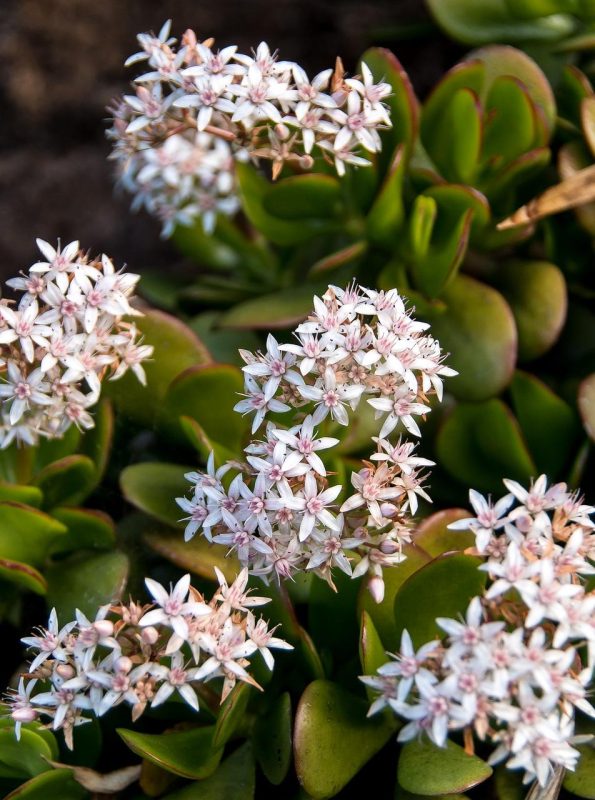
Commonly known as the Jade Plant, Crassula ovata is a classic succulent cherished for its glossy, rounded leaves that resemble jade stones. This plant has gained popularity not only for its aesthetic appeal but also for its significance in various cultures. In Feng Shui, the Jade Plant is believed to bring good luck and prosperity, making it a staple in homes across the globe.
Jade Plants are surprisingly resilient and easy to grow, thriving in well-draining soil and benefiting from bright, indirect sunlight. They prefer to dry out completely between waterings, making them a low-maintenance choice for busy individuals. One interesting aspect of Jade Plants is their ability to grow quite large, even developing a tree-like appearance over time. With patience and care, a well-tended Jade Plant can become a cherished centerpiece in your home.
Echeveria
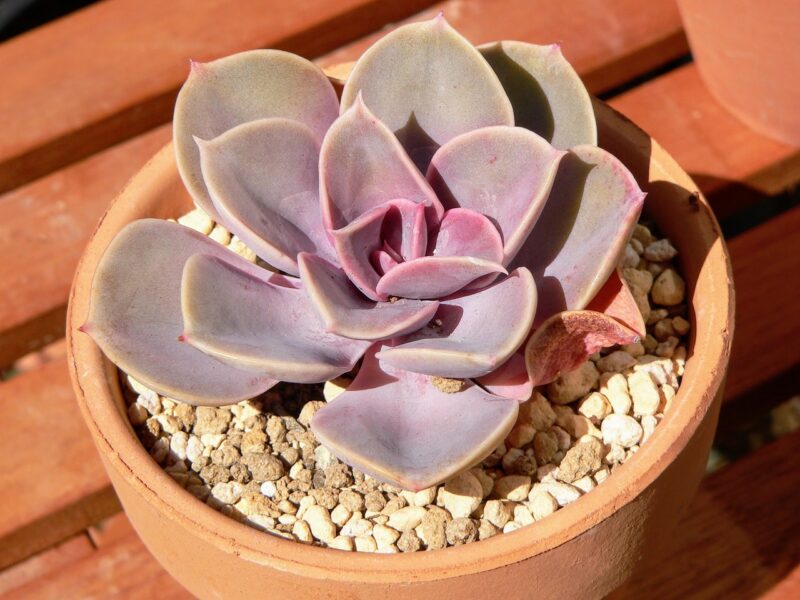
Echeveria is a diverse genus of succulents that encompasses a wide variety of shapes, sizes, and colors. Originating from semi-desert regions in Central America, these rosette-forming plants are known for their striking appearance. Echeveria comes in hues ranging from soft pastels to vibrant, deep colors, making them a favorite among collectors.
What makes Echeveria particularly appealing is its adaptability. It thrives in bright light but can tolerate some shade, making it versatile for both indoor and outdoor settings. These succulents prefer well-draining soil and require infrequent watering to prevent root rot. Echeveria plants are often used for terrariums, floral arrangements, and as focal points in succulent gardens due to their eye-catching aesthetic. Their unique shapes and colors make each variety a standout in its own right.
Plush Plant (Echeveria pulvinata)

The Plush Plant, or Echeveria pulvinata, is a delightful succulent characterized by its fuzzy, velvety leaves. This charming plant’s foliage varies in color from green to a soft silvery hue, often adorned with hints of pink or red at the tips. Native to Mexico, the Plush Plant’s distinctive texture sets it apart from many of its succulent counterparts.
While aesthetically pleasing, the care of the Plush Plant is fairly straightforward. It thrives in bright, indirect sunlight and prefers to dry out between waterings, just like other Echeveria varietals. The leaves’ fuzziness serves as an adaptation to retain moisture, helping the plant survive in arid conditions. This unique trait makes the Plush Plant not only a visual delight but also a fascinating study in how succulents adapt to their environments.
Red Velvet Plush Plant (Echeveria pulvinata ‘Ruby’)

Closely related to the Plush Plant, the Red Velvet Plush Plant, or Echeveria pulvinata ‘Ruby’, takes the allure of its predecessor one step further with its stunning vibrant coloration. This succulent features striking red-violet edges with soft, velvety leaves that create an almost dreamlike appearance. It’s a showstopper in any collection and draws the eye with its unique blend of color and texture.
Just like the Plush Plant, the Red Velvet Plush Plant requires similar care. Bright light is essential for maintaining its vibrant colors, and it should be watered only when the soil is dry. Its rarity and captivating look have made it a sought-after specimen among succulent enthusiasts. Caring for this plant can be incredibly rewarding, as its color intensifies under the right growing conditions, revealing its full potential.
Lithops
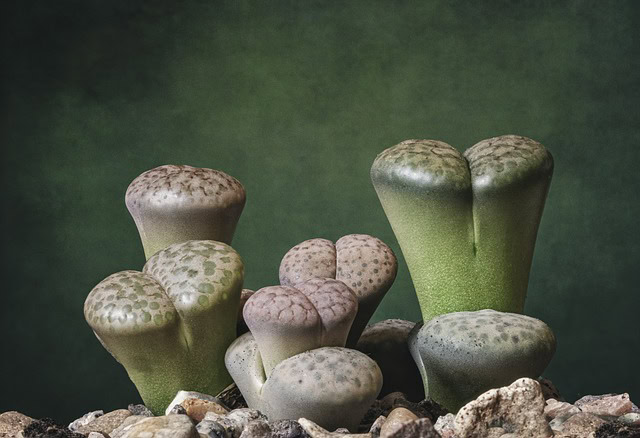
Lithops, commonly referred to as “living stones,” are an extraordinary type of succulent native to southern Africa. What sets Lithops apart is their remarkable resemblance to small pebbles or stones, serving as a perfect camouflage in their native environments. This unique appearance comes from their split leaves that allow them to blend seamlessly with their surroundings, providing protection against herbivores.
Caring for Lithops can be a delightful challenge. They thrive in bright light and require a well-draining soil mix to prevent overwatering, which is a common pitfall for many succulent enthusiasts. Lithops need minimal watering, especially during their dormant period, which typically occurs in summer. One of the fascinating things about Lithops is their blooming cycle; they produce beautiful daisy-like flowers that emerge between their stone-like leaves, showcasing nature’s creativity.
Bear’s Paw Succulent (Cotyledon Ladismithiensis)
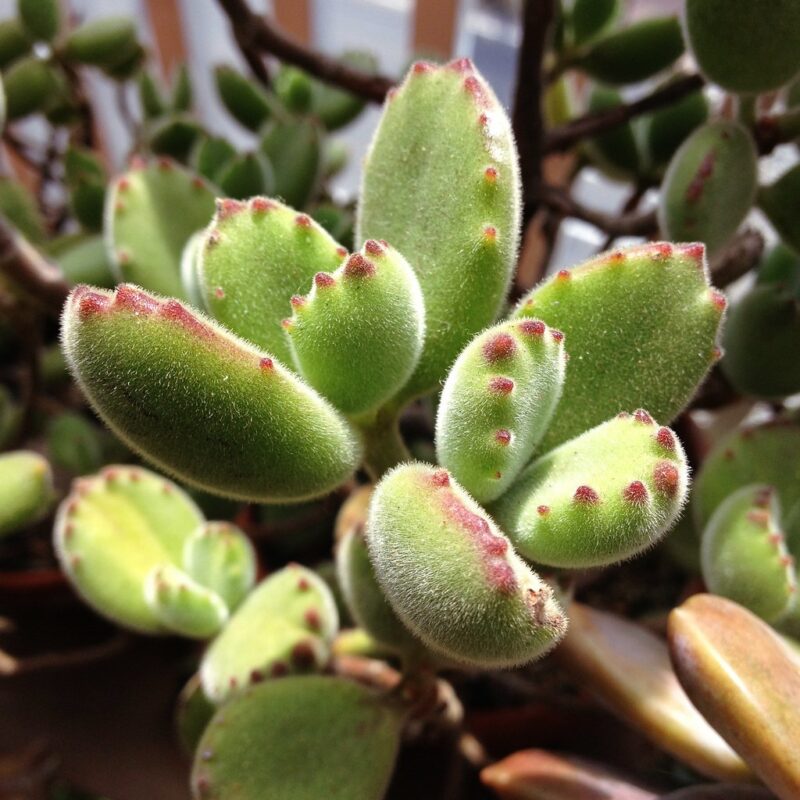
The Bear’s Paw Succulent, or Cotyledon ladismithiensis, is a lush plant with thick, finger-like leaves that resemble bear paws—hence the name. This succulent adds a playful touch to any collection and entertains with its dynamic growth. Native to South Africa, the Bear’s Paw’s leaves are often muted green with a hint of reddish edges when exposed to bright sunlight.
Caring for the Bear’s Paw is straightforward, requiring bright light and a well-draining soil mix. Like many succulents, it should be watered only when the soil is completely dry. What makes this plant particularly appealing is its unique growth pattern; as it matures, it can develop multiple “paws,” providing a delightful visual effect. In spring, it rewards caretakers with clusters of yellow-orange flowers that bloom atop long stems, adding further charm to this lovable succulent.
String of Pearls (Senecio rowleyanus)
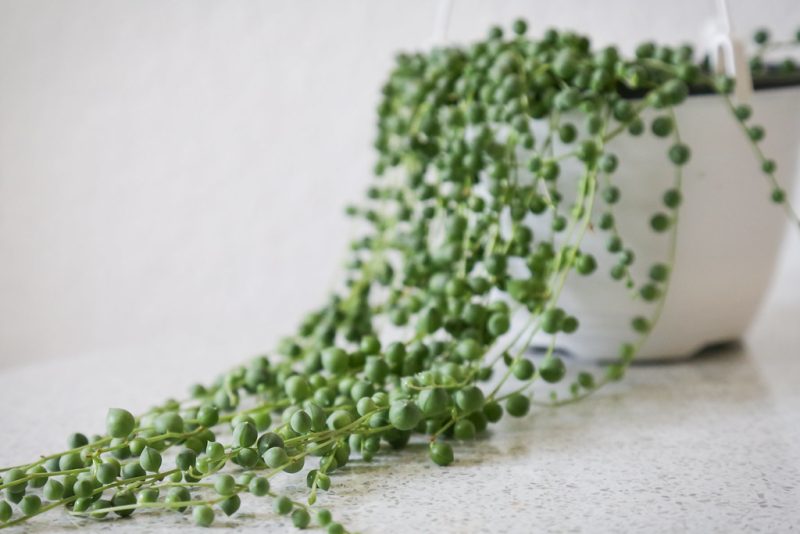
The String of Pearls is a whimsical trailing succulent that features long, cascading strands of bead-like leaves. Native to South Africa, this succulent has become a favorite among indoor gardeners thanks to its distinctive appearance, reminiscent of a green jewelry string. Its unique growth habit makes it a perfect choice for hanging planters, where it can spill over and create a stunning visual display.
Caring for String of Pearls requires attention to light and watering. This succulent thrives in bright light but should be protected from intense sunlight, which can scorch its delicate leaves. Like many succulents, it prefers to dry out completely between waterings. One of the most captivating aspects of this succulent is its ability to flower; when conditions are just right, it produces tiny, tubular white flowers that emanate a sweet fragrance, adding to the allure of this enchanting plant.
Pincushion Cactus (Mammillaria crinita)
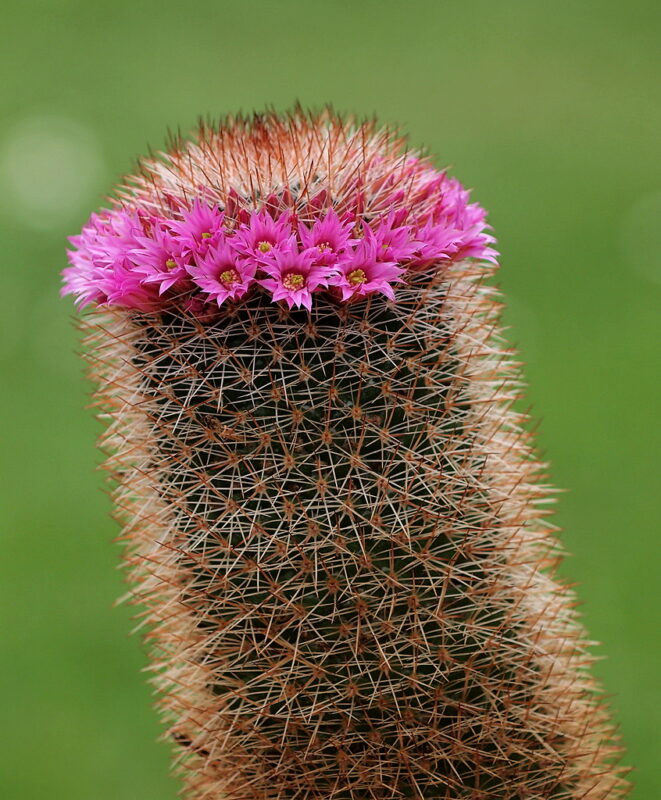
The Pincushion Cactus, or Mammillaria crinita, is a charming little succulent that packs a lot of character. Known for its densely covered spines and vibrant flowers, this cactus is indigenous to Mexico and thrives in arid conditions. What makes this succulent particularly appealing is its spherical shape, which can grow quite large over time, adding a visual focal point to any display.
Caring for the Pincushion Cactus is relatively uncomplicated. It prefers bright sunlight and should be watered infrequently, allowing the soil to dry completely between waterings. During the blooming season, expect to be rewarded with stunning pink or white flowers that emerge from the top of the cactus, creating a breathtaking spectacle. This resilience and beauty make the Pincushion Cactus a wonderful addition to succulent gardens.
Snake Plant (Sansevieria trifasciata)
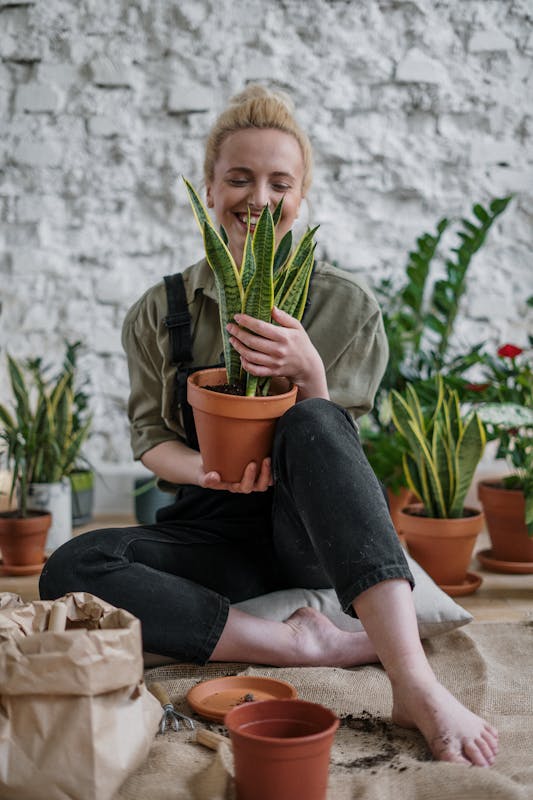
The Snake Plant, also known as Mother-in-Law’s Tongue, is one of the most popular houseplants worldwide. Its tall, upright leaves, which can reach several feet in height, are characterized by their striking green and yellow banding. Native to Africa, this succulent is often praised for its ability to tolerate low light and irregular watering, making it a favorite among those new to plant care.
While it thrives in a variety of conditions, the Snake Plant prefers bright indirect light and well-draining soil. One of its remarkable features is its air-purifying qualities, removing toxins from the atmosphere, making it a perfect choice for indoor spaces. The Snake Plant’s low maintenance and stylish appearance combined with its health benefits make it an attractive choice for just about anyone looking to add greenery to their lives.
Haworthia Fasciata “Zebra Plant”
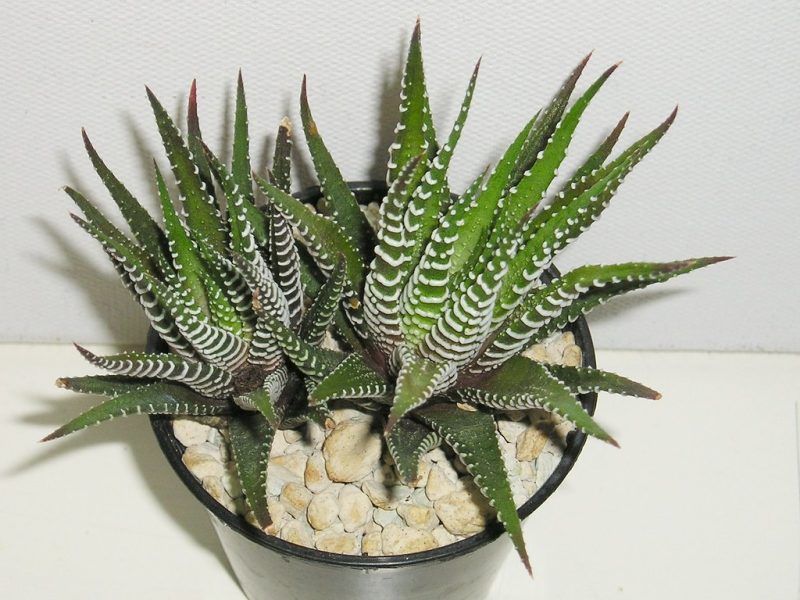
The Zebra Plant, or Haworthia fasciata, is another favorite among succulent lovers. This charming plant features thick, fleshy leaves adorned with distinctive white stripes that resemble a zebra’s stripes. Native to South Africa, the Zebra Plant is perfect for compact spaces and adds a touch of whimsy to any collection.
Caring for the Zebra Plant is relatively easy. It thrives in bright, indirect light but also tolerates low-light conditions, making it an excellent choice for indoor environments. Watering should be moderate; allowing the soil to dry out between waterings is essential for maintaining its health. Beyond its aesthetic qualities, the Zebra Plant is known for its longevity, making it a treasured addition to any succulent collection.
Haworthia cooperi
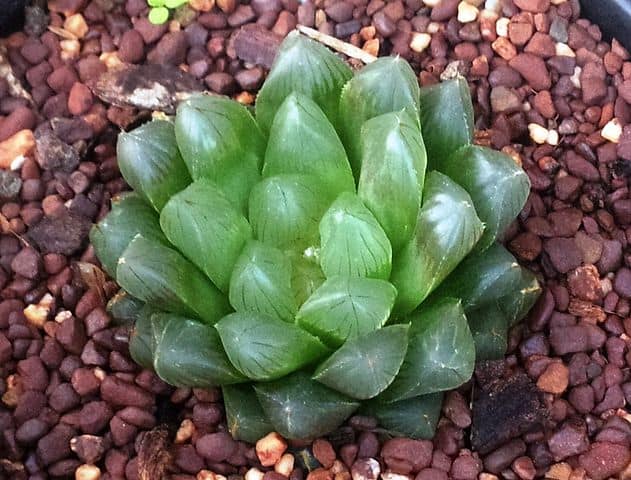
Haworthia cooperi is a remarkable succulent noted for its transparent, jelly-like leaves. This fascinating feature allows light to filter through the leaves, creating an ethereal glow that can captivate any observer. Native to South Africa, this succulent thrives in rocky terrains, reflecting its ability to adapt to arid environments.
When caring for Haworthia cooperi, providing bright indirect light is key, as direct sunlight may scorch its delicate leaves. It prefers to dry out completely between waterings, which is a common requirement for many succulents. This captivating plant offers both visual intrigue and low-maintenance care, making it a fantastic choice for any succulent lover looking to add variety to their collection.
Hoya Kerrii (Lucky-Heart) Plant

Hoya Kerrii, often called the Lucky-Heart plant, is a delightful succulent native to Southeast Asia. Characterized by its heart-shaped leaves, it serves as a popular symbol of love, making it an ideal gift for romantic occasions. This trailing plant can grow quite long, producing clusters of waxy, star-shaped flowers that smell lovely and add a tropical vibe to any indoor space.
Caring for Hoya Kerrii is not difficult, as it prefers bright, indirect sunlight and should be watered only when the soil is dry. It does best in well-draining soil, and this succulent enjoys humidity, so consider misting it occasionally. The Hoya Kerrii’s symbolism and charming appearance make it a beloved choice for those looking to share a plant with someone special.
Pig’s Ear (Cotyledon orbiculata)

Pig’s Ear, or Cotyledon orbiculata, is a quirky succulent with thick, rounded leaves that resemble the ears of a pig. This plant exhibits a bluish-green color with reddish edges, adding a playful touch to any collection. Native to Africa, Pig’s Ear is a resilient plant that can tolerate varying conditions, making it a favorite among succulent enthusiasts.
When caring for Pig’s Ear, provide it with bright, indirect sunlight, and ensure the soil is well-draining. This succulent should be watered sparingly, allowing it to dry out entirely between waterings. During the blooming season, you may be rewarded with clusters of yellow, tubular flowers that rise on tall spikes, offering a stunning contrast to its unique foliage.
Zwartkop (Aeonium arboreum ‘Zwartkop’)

Zwartkop, or Aeonium arboreum ‘Zwartkop,’ is a striking succulent known for its dark purple, almost black rosettes. This captivating plant adds a dramatic contrast to any collection and can grow into a small tree-like structure over time. Native to the Canary Islands, Zwartkop thrives in full sun and well-drained soil, adapting well to various conditions.
Caring for Zwartkop requires attention to lighting and watering. It prefers bright sunlight and should be watered infrequently, allowing the soil to dry out between waterings. Zwartkop stands out not only for its rich color but also for its tall stalks that blossom with vibrant yellow flowers, creating a stunning display of beauty.
Sunburst Succulent (Aeonium ‘Sunburst’)

The Sunburst Succulent, known as Aeonium ‘Sunburst,’ is a delightful plant characterized by its vibrant green and yellow variegated leaves. This striking color pattern resembles sunshine, adding warmth and cheer to any space. Like other Aeonium varieties, Sunburst is native to the Canary Islands and thrives in bright sun exposure.
Caring for the Sunburst Succulent involves providing it with well-draining soil and ample sunlight. It prefers to dry out between waterings, which is essential for preventing root rot. With its unique coloration and ability to grow into a compact shrub, the Sunburst Succulent is sure to brighten your home and bring a touch of sunshine into your life.
Mother of Thousands Plant (Bryophyllum daigremontianum or Kalanchoe daigremontiana)

Mother of Thousands, known scientifically as Bryophyllum daigremontianum, is a fascinating succulent infamous for its reproduction method. Small plantlets develop on the edges of its leaves, allowing this succulent to propagate effortlessly. Native to Madagascar, Mother of Thousands can create a lush and vibrant display of green, making it a unique addition to any garden or indoor setting.
Caring for Mother of Thousands involves providing it with bright light and a well-draining soil mix. It thrives in warm conditions and should be watered when the soil dries out. However, be cautious, as this succulent can become invasive if not carefully contained. Its unique propagation ability is a captivating aspect for collectors, forming a plant that seems to be perpetually renewing itself.
Paddle Plant (Kalanchoe thyrsiflora or Kalanchoe luciae)
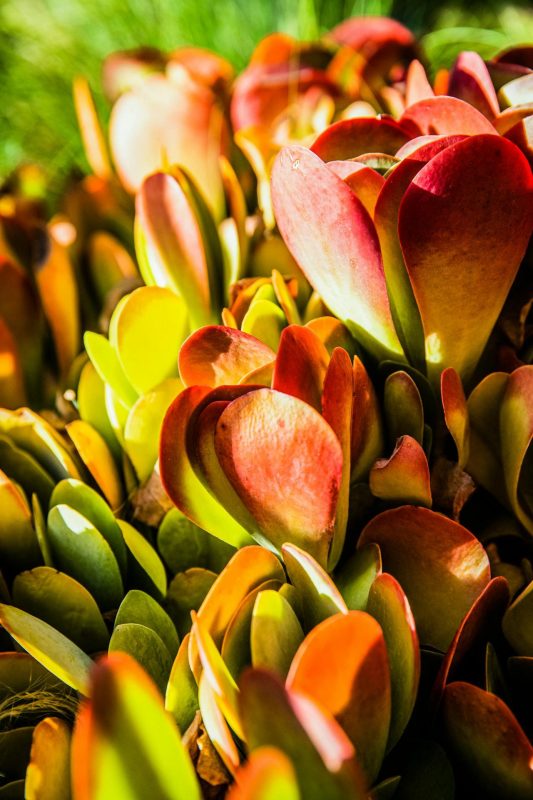
The Paddle Plant is celebrated for its large, paddle-shaped leaves that resemble bright green oars. With edges that turn a fiery red in bright sunlight, this succulent is a visual delight. Native to South Africa, Paddle Plants thrive in sunny, warm environments, making them suitable for drought-tolerant gardens.
Caring for the Paddle Plant involves ensuring that it receives plentiful sunlight and well-draining soil. This succulent should be watered thoroughly, allowing the soil to dry out completely between waterings. The charming round leaves and vibrant colors make the Paddle Plant an attractive choice for succulent enthusiasts. It also produces yellow, tubular flowers on tall spikes during the blooming season, adding to its appeal.
Woolly Senecio or Cocoon Plant (Caputia tomentosa)

The Woolly Senecio, also known as the Cocoon Plant, is a unique succulent featuring fuzzy, wool-like leaves that have a soft, nurturing quality. This succulent hails from South Africa and is known for its vibrant green foliage that takes on a silvery hue. The distinctive appearance of the Woolly Senecio creates a striking contrast in any succulent arrangement.
Caring for the Woolly Senecio is straightforward. It thrives in bright light and requires infrequent watering, allowing the soil to dry out completely between waterings. Its fuzzy leaves serve as an adaptation for moisture retention, making it well-suited for arid environments. Apart from being visually appealing, the Woolly Senecio offers a touch of whimsy and a unique texture that enhances any succulent collection.
Pussy Ears (Kalanchoe tomentosa)
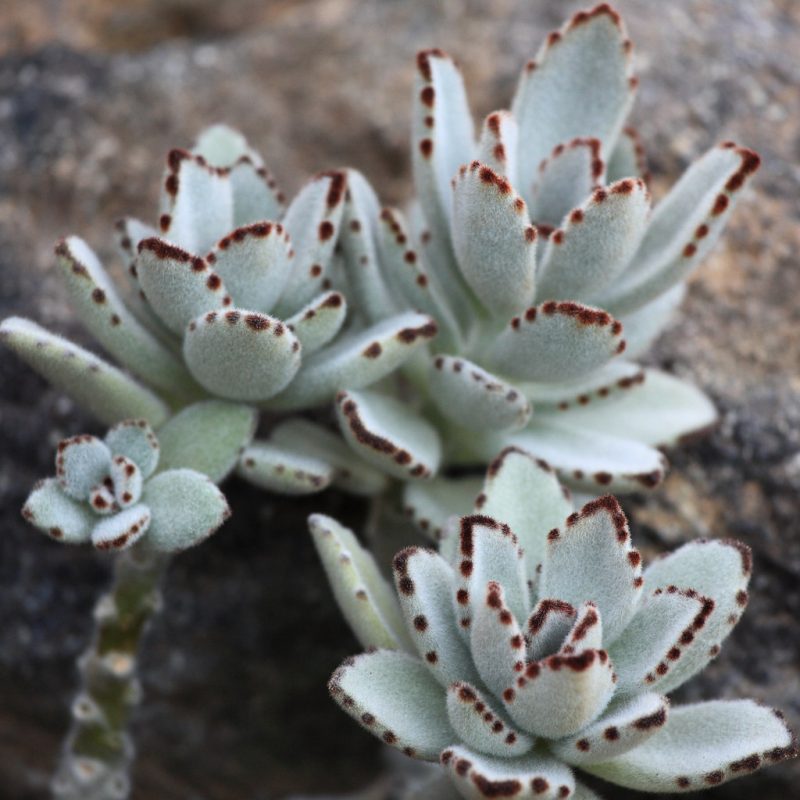
Pussy Ears, scientifically known as Kalanchoe tomentosa, are playful succulents famous for their furry, rounded leaves resembling the ears of a kitten. This lovable plant brings a sense of fun and charm to any environment. Native to Madagascar, Pussy Ears thrive in warm, well-lit settings, making them a popular choice for indoor gardening.
Caring for Pussy Ears is easy, as they prefer bright, indirect light and should be watered only when dry. The furry texture of the leaves not only adds interest but also helps the plant retain moisture, allowing it to flourish in arid conditions. During the spring, Pussy Ears may surprise you with clusters of delicate yellow flowers that emerge on long, slender stems, bringing a cheerful pop of color to your collection.
Moon Cactus
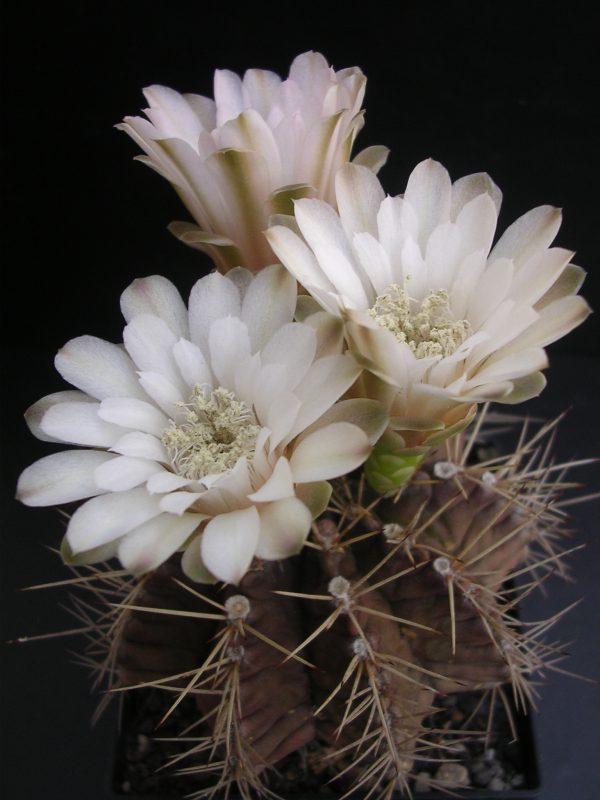
The Moon Cactus, or Gymnocalycium mihanovichii, is a truly unique succulent that features a brightly colored top grafted onto a green base cactus. Its vibrant hues, often neon in appearance, make it stand out in any collection. Originating from South America, the Moon Cactus thrives in warm climates and is known for its striking appearance, often resembling a mini alien landscape.
Caring for a Moon Cactus involves providing bright light and ensuring that it doesn’t receive too much direct sunlight, which can scorch the top. Watering should be moderate; like many succulents, it prefers to dry out completely between watering sessions. The colorful, spiky crown of the Moon Cactus creates an otherworldly aesthetic that is sure to spark enjoyment in anyone that encounters it.
Agave

Agave is a striking genus known for its architectural beauty and striking forms. Native to the Americas, these plants are often characterized by their rosettes of thick, fleshy leaves that can vary significantly in color and texture. Some agave species feature dramatic spines or serrations along their leaf edges, creating a bold visual impact. The Agave Americana, or Century Plant, is a popular example that can grow to impressive heights and is often used in xeriscaping due to its drought resistance.
Caring for agave primarily involves providing well-draining soil and plenty of sunlight. They are drought-tolerant and should only be watered when the soil is dry, making them perfect for low-maintenance gardens. Agave plants are known for their impressive flower spikes that can reach towering heights when they bloom, displaying clusters of vibrant flowers. This unique reproductive strategy often leads to the mother plant dying after flowering—a natural part of their life cycle that ensures propagation through offsets.
Roseum Sedum (Sedum spurium ‘Roseum’)
Roseum Sedum, more commonly referred to as Sedum spurium ‘Roseum,’ is a comfortably hardy ground cover succulent. Known for its lush green foliage that turns to vibrant shades of red and pink in the summer, this fast-spreading plant thrives in various conditions, making it a favorite choice among gardeners. Its delightful star-shaped flowers bloom in early summer, attracting pollinators and adding a lovely touch to rock gardens, container arrangements, and borders.
Caring for Roseum Sedum is relatively simple as it requires minimal attention. It flourishes in full sun but will also tolerate partial shade. The key to keeping it healthy is well-draining soil and infrequent watering. This succulent’s resilience makes it suitable for drought-prone areas, and its decorative nature enhances any landscape beautifully. Furthermore, it’s an excellent option for beginners hoping to start their succulent journey, as it’s as forgiving as it is attractive.
Torch Plant (Aristaloe aristata)

The Torch Plant, scientifically known as Aristaloe aristata, is a beautiful South African succulent admired for its bold rosettes and stunning flower display. The leaves are loaded with spiky edges and are typically green or bluish-gray, forming a tight cluster. When spring arrives, this plant produces tall, upright flower spikes adorned with tubular orange or red blossoms that are attractive to hummingbirds and pollinators.
Caring for the Torch Plant involves providing bright, indirect sunlight and well-draining soil. It’s essential to allow the soil to dry out between waterings to prevent root rot. This succulent thrives in warmer temperatures and can tolerate some drought, making it a fantastic choice for succulent lovers looking for a plant that combines beauty and hardiness. With its dramatic flowers and unique leaf structure, the Torch Plant is a statement piece in any garden.
Hens and Chicks Succulent (Sempervivum tectorum)

Hens and Chicks, scientifically known as Sempervivum tectorum, is a classic succulent that has captivated gardeners for generations. True to its name, this plant forms rosettes (the “hens”) that produce smaller rosettes, or “chicks,” around their edges. This intricate growing pattern adds visual depth and interest to any garden. Hens and Chicks come in various colors, from greens to deep purples, and can produce delightful flowers in the summer.
Caring for Hens and Chicks is straightforward—they thrive in full sun and tolerate poor soil conditions. This hardy succulent is drought-resistant and prefers to dry out between waterings, making it ideal for rock gardens or Mediterranean-style landscaping. The unique rosette shape and the ability to propagate make Hens and Chicks a favorite among succulent enthusiasts. Additionally, they’re great for beginners due to their tough nature and minimal care requirements.
Firestick Plant ‘Sticks on Fire’ (Euphorbia tirucalli ‘Sticks on Fire’)

The Firestick Plant, also known as Euphorbia tirucalli ‘Sticks on Fire’, is a visually stunning succulent that captivates with its iconic fiery color. The plant’s pencil-like stems turn a brilliant red-orange when exposed to bright sunlight, resembling flames—a striking feature that adds drama to any setting. Native to Africa, this low-maintenance succulent is as easy to care for as it is beautiful.
Caring for the Firestick Plant is easy: it enjoys bright, direct sunlight and thrives in well-draining soil. Watering should be kept to a minimum, allowing the soil to dry out completely between waterings. One thing to note is that all parts of this plant contain a milky latex sap that can be irritating to the skin, so gloves should be worn when handling. With its vibrant colors and bold presence, the Firestick Plant serves as an incredible statement piece in gardens or indoor displays.
Candelabra Cactus (Euphorbia trigona)
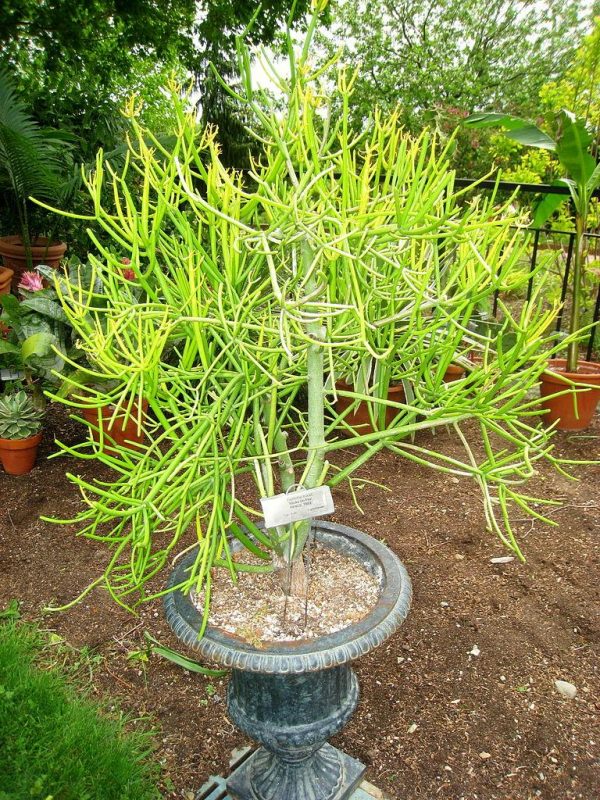
The Candelabra Cactus, or Euphorbia trigona, is an eye-catching succulent known for its tall, upright growth habit and candelabra-like shape. Reaching heights of up to 6 feet, this plant showcases tall, green, triangular stems adorned with spine-like structures that add an exciting texture. Native to Africa, the Candelabra Cactus is a favorite for indoor plant collections and can also thrive outdoors in warmer climates.
Caring for the Candelabra Cactus involves providing it with bright, indirect light while ensuring that it receives sufficient water during growing seasons. Like other succulents, it prefers well-draining soil, and overwatering should be avoided to prevent root rot. This cactus’s unique shape and low maintenance care make it an appealing choice for those looking to elevate their indoor or outdoor garden aesthetics while enjoying a resilient, handsome plant.
Queen of the Night Cactus (Epiphyllum oxypetalum)

Known for its enchanting blooms that open at night, the Queen of the Night Cactus (Epiphyllum oxypetalum) is a true marvel in the succulent kingdom. This epiphytic cactus originates from Central and South America and boasts large, fragrant, white flowers that bloom in the dark, attracting nocturnal pollinators. Its glossy green pads can reach substantial lengths, presenting a stunning contrast to the delicate blooms.
Caring for the Queen of the Night requires a bit of special attention. It thrives in bright, indirect light and prefers well-draining soil mixed with some organic matter. Watering should be done when the soil feels dry to the touch. This plant needs humidity to flourish, so placing it in a bathroom or kitchen can be beneficial. The allure of its nighttime blooms makes the Queen of the Night a favorite among gardeners who cherish unique and exotic plants.
German Empress (Disocactus phyllanthoides)

The German Empress, or Disocactus phyllanthoides, is a beautiful succulent with unique trailing vines and striking pink flowers. Native to Central America, this epiphytic cactus is often seen cascading from hanging baskets or shelves. The flattened stems of the German Empress create a lovely texture, while the flowers bloom in the late spring to summer, adding a pop of vibrant color.
Caring for the German Empress entails placing it in bright indirect light and watering it thoroughly, allowing it to dry out between sessions. This succulent can tolerate some neglect, but regular watering during its growing season will encourage lush growth and abundant blooms. With its charming appearance and potential for dramatic floral displays, the German Empress is an exceptional choice for those looking to introduce a touch of elegance into their succulent collection.
Elephant Bush (Portulacaria afra)
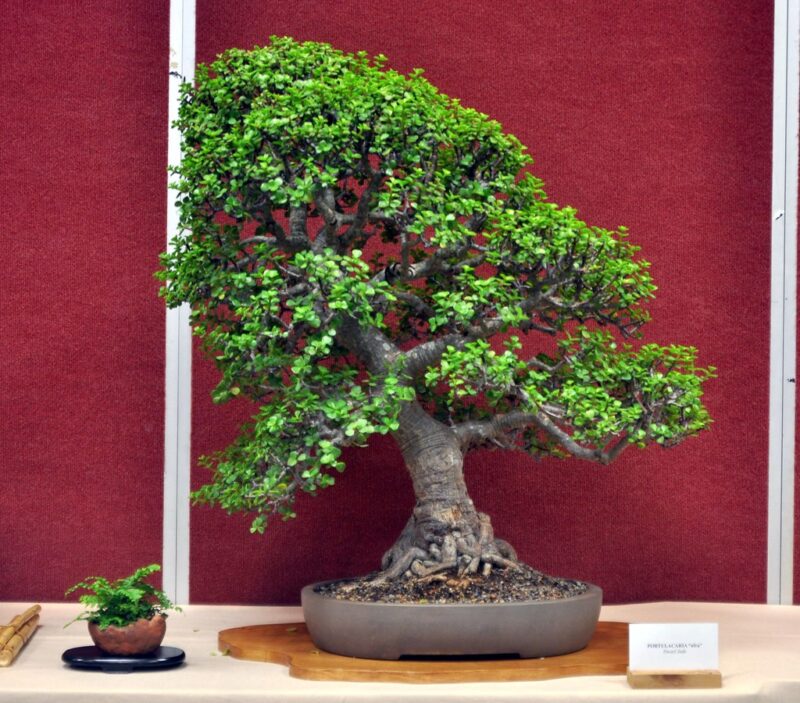
The Elephant Bush, or Portulacaria afra, is a delightful succulent known for its fleshy leaves and bushlike appearance. Native to South Africa, this plant can grow into a substantial shrub when given the right conditions. Its small, rounded leaves vary in color from green to a darker hue, depending on environmental factors and sunlight. The Elephant Bush is praised for its resilience and unique texture.
When caring for the Elephant Bush, ensure that it receives bright light while keeping the soil well-draining. It’s drought-tolerant and should be watered only when the soil is thoroughly dry. This succulent also works well in a bonsai setup, allowing for creative design possibilities. The Elephant Bush is often regarded as a symbol of strength and resilience in the plant world, adding an uplifting presence to any indoor or outdoor arrangement.
Airplane Plant/Propeller Plant (Crassula perfoliata var. minor, formerly Crassula falcata)

The Airplane Plant, scientifically known as Crassula perfoliata var. minor, or Propeller Plant, is a unique succulent characterized by its distinct leaves that resemble propellers. These flat, overlapping leaves are often pale green with reddish edges, creating a striking visual effect. Native to South Africa, this succulent thrives in arid conditions and is recognized for its attractive form and low care requirements.
Caring for the Airplane Plant involves providing it with bright, indirect light along with well-draining soil. Water it when the soil is dry to the touch, allowing it to enjoy drier periods between waterings. During the summer, this succulent showcases lovely clusters of red flowers atop tall stems, providing an added bonus to its already impressive look. With its unique leaf patterns and resilience, the Airplane Plant stands out as a bold, captivating choice for succulent enthusiasts.
Buttons on a String (Crassula Rupestris)

Buttons on a String, or Crassula Rupestris, is a delightful succulent known for its distinctive, rounded leaves that resemble small buttons strung together on cascading stems. This charming plant features a layered growth habit, creating an attractive curtain of green that is perfect for hanging baskets or containers. Native to South Africa, Crassula Rupestris thrives in well-draining soils and enjoys bright light.
Caring for Buttons on a String is relatively easy. It prefers a bright, sunny location but can tolerate partial shade. Water this succulent when the soil has dried out completely; it’s critical to avoid overwatering. In the right conditions, it can produce lovely clusters of red or pink flowers in the summer, adding further interest to its already enchanting form. The visual appeal and low-maintenance nature of Buttons on a String make it an ideal choice for both novice and seasoned succulent enthusiasts.
Devil’s Backbone (Euphorbia tithymaloides)

Devil’s Backbone, scientifically known as Euphorbia tithymaloides, is a unique succulent that showcases an eye-catching zigzag pattern in its stems. This intriguing plant is native to the Caribbean and parts of Central America, and it features dark green, flat stems that give it a distinctive look. The name “Devil’s Backbone” comes from the dramatic, angular shape of its growth and its spiky, thorny top edges.
Caring for Devil’s Backbone requires a sunny location, as it thrives in bright light. Use well-draining soil to help prevent root rot. Water the plant moderately, allowing it to dry out between waterings. This succulent can produce small, yellow-green flowers under the right conditions, further adding interest to its already stunning appearance. As with any Euphorbia, handle with care, as they contain a milky sap that can be irritating to the skin. Devil’s Backbone stands out as an intriguing specimen that captivates the eye.
Purple Spurge (Euphorbia amygdaloides ‘Purpurea’)
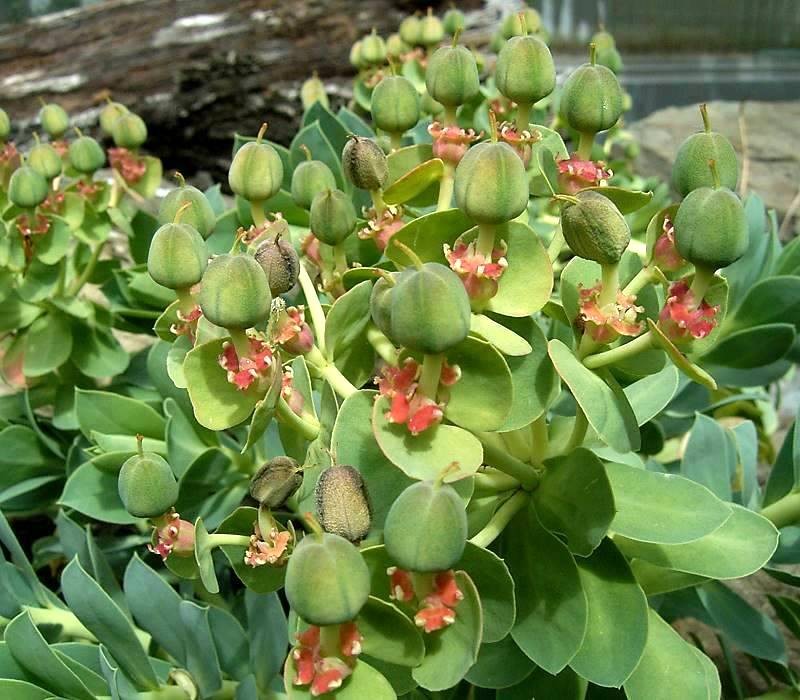
Purple Spurge, or Euphorbia amygdaloides ‘Purpurea’, is a visually striking succulent that adds a splash of color to any garden or indoor arrangement. This plant features rich, dark purple foliage that stands out beautifully against green background plants. Known for its resilience, Purple Spurge grows well in a variety of climates while providing low-maintenance beauty.
Caring for Purple Spurge involves placing it in a sunny spot with well-draining soil. This succulent is drought-resistant and should be watered only when necessary, allowing the soil to dry out completely between waterings. During the spring and summer months, you can expect small, yellow flowers that provide a refreshing contrast to the plant’s purple leaves. The unique coloration and carefree nature of Purple Spurge make it a lovely addition to succulent collections.
Baby Toes (Fenestraria rhopalophylla)

Baby Toes, scientifically referred to as Fenestraria rhopalophylla, is a captivating succulent that excites collectors with its unique “toes”-like appearance. Each plump, finger-like leaf has a translucent tip, giving the illusion of tiny feet emerging from the ground. Native to South Africa, Baby Toes thrives in well-draining soil and is an eye-catching choice for any succulent arrangement.
Caring for Baby Toes requires bright, indirect sunlight and moderate watering. Allow the soil to dry out between waterings, as this succulent is particularly sensitive to excess moisture. In their natural habitat, Baby Toes bloom delightful yellow flowers that can add further charm to this quirky plant. Their unusual appearance and easy-going nature make Baby Toes a favorite for both new and experienced succulent collectors.
Bunny Succulent (Monilaria moniliformis)

The Bunny Succulent, or Monilaria moniliformis, is a delightful plant that gets its name from its cute, rabbit-like appearance. With thick, cylindrical leaves that resemble bunny ears, this succulent brings a whimsical touch to any collection. Native to South Africa, the Bunny Succulent has a fascinating growth pattern where it goes dormant in summer, making it essential to adapt care according to seasonal changes.
Caring for the Bunny Succulent involves placing it in bright light and using a well-draining soil mix. It requires infrequent watering, especially during its dormant periods; be careful not to overwater this plant. The Bunny Succulent may produce delicate white or pink flowers, adding an adorable touch to its whimsical look. This charming succulent is perfect for those looking to add a playful element to their home or garden.
Jelly Bean Plant (Sedum rubrotinctum)

The Jelly Bean Plant, scientifically known as Sedum rubrotinctum, is a cheerful succulent that features plump, jelly-like leaves resembling small beans. The leaves display a vibrant green color, often highlighted with reddish tips in bright sunlight, enhancing their visual appeal. This easy-to-care-for plant is native to Mexico and is popular among succulent lovers for its fun appearance.
Caring for the Jelly Bean Plant involves providing it with plenty of bright, indirect light. Use well-draining soil and allow it to dry out completely between watering sessions to prevent root rot. During the summer months, the Jelly Bean Plant may produce yellow star-shaped flowers that bloom on tall stems, creating a delightful display. With its cheerful look and minimal care needs, the Jelly Bean Plant is an excellent addition to any succulent collection.
Ghost Plant (Graptopetalum paraguayense)
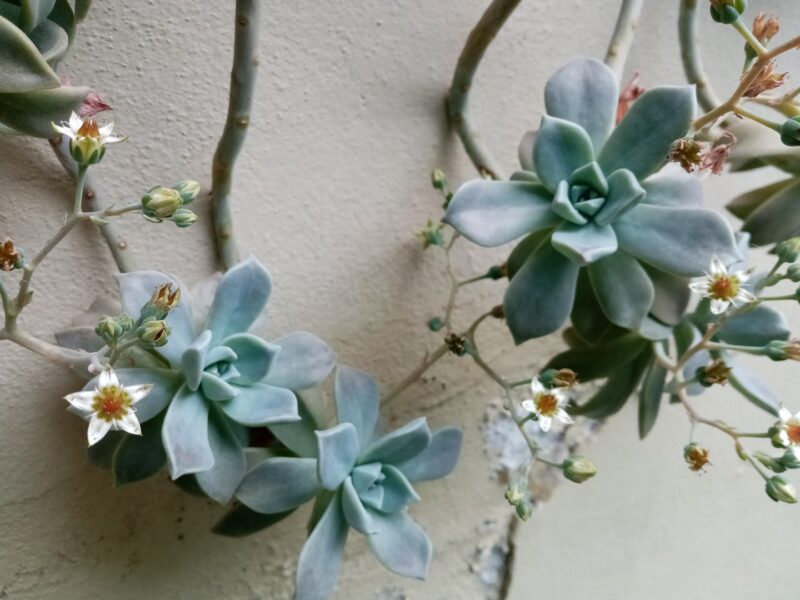
The Ghost Plant, or Graptopetalum paraguayense, is known for its enchanting, pale gray or blue leaves that take on a ghostly appearance. This succulent forms rosettes of leaves that can produce offsets, making it an excellent choice for creating larger displays. The Ghost Plant is native to Mexico and thrives well in various growing conditions.
Caring for the Ghost Plant involves providing bright, indirect sunlight and using well-draining soil to prevent root rot. Water this succulent when the top layer of soil feels dry to the touch. Under optimal conditions, you can expect lovely pink flowers to emerge in the summer. Its ethereal color coupled with low maintenance makes the Ghost Plant an ideal candidate for any succulent enthusiast.
‘Cobweb Hens and Chicks’ (Sempervivum arachnoideum)

The ‘Cobweb Hens and Chicks’ (Sempervivum arachnoideum) is a captivating variant of the classic Hens and Chicks with a unique spin. This succulent is characterized by its rosettes covered in fine, web-like hairs that create a striking cobweb effect. This fascinating appearance isolates the plant as a distinctive and sought-after addition in collections.
Caring for Cobweb Hens and Chicks involves placing them in well-draining soil and providing bright, direct sunlight. Like other Hens and Chicks, they thrive in poor soils and can tolerate drought conditions, making them easy to maintain. They may produce star-shaped flowers in the summer, adding a splash of color to complement their unique appearance. The whimsical nature of Cobweb Hens and Chicks makes them a charming choice for both indoor and outdoor gardens.
Purslane (Portulaca oleracea)
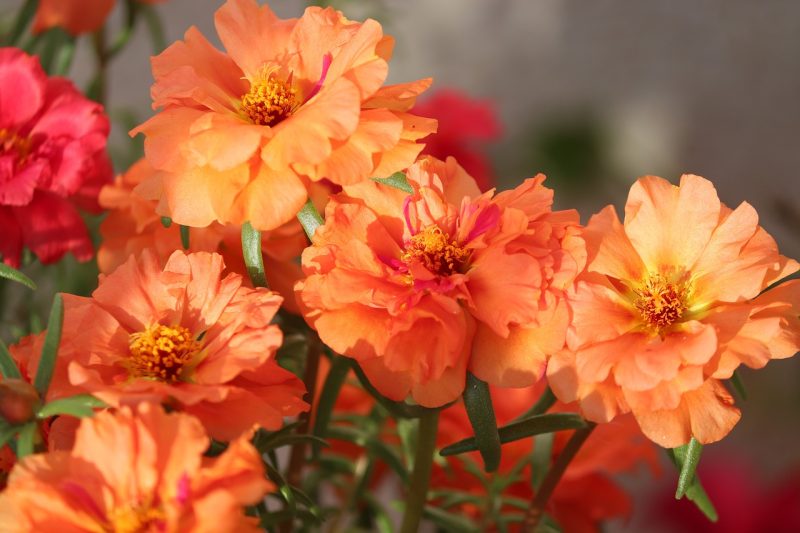
Purslane, or Portulaca oleracea, is an intriguing succulent that doubles as a culinary herb in many cultures due to its edible leaves and stems. This vigorous grower is recognized for its fleshy, oval leaves that provide a lush green carpet when planted as a ground cover. Purslane blooms vibrant yellow flowers in full sunlight, making it a colorful addition to any garden.
Caring for Purslane is straightforward—it thrives in full sun and well-draining soil. This succulent is drought-tolerant and should be watered only when the soil has dried out completely. Its ability to adapt to various conditions, combined with the added benefit of being edible, make Purslane a functional and visually appealing plant for any garden or container.
Creeping Inchplant or Turtle Vine (Callisia repens)
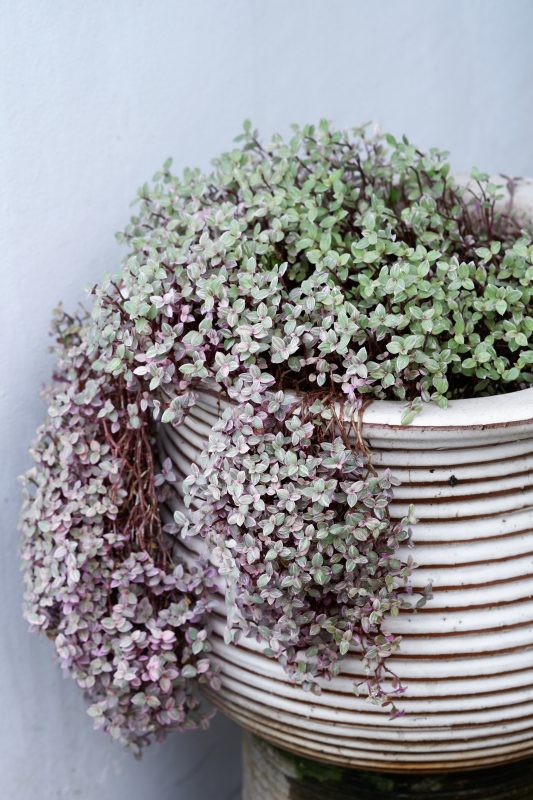
The Creeping Inchplant, also known as Turtle Vine (Callisia repens), is a charming succulent that boasts trailing stems adorned with small, rounded, variegated leaves. The foliage often displays shades of green, cream, and pink, creating a delightful contrast. This low-growing plant is perfect for hanging baskets or as a ground cover in larger containers.
Caring for the Creeping Inchplant involves providing it with bright, indirect sunlight. It prefers well-draining soil and should be watered when the soil feels dry to the touch. This succulent is relatively low maintenance, and its lovely trailing habit makes it a wonderful addition to succulent displays or terrariums. The unique texture and color of the Creeping Inchplant add visual interest, creating a cozy, inviting atmosphere.
Little Pickles (Crassothonna capensis, formerly Othonna capensis)

Little Pickles, scientifically known as Crassothonna capensis, is an adorable succulent characterized by its small, cylindrical green leaves that resemble tiny pickles. This charming plant is native to South Africa and develops a lovely trailing or sprawling growth habit, making it perfect for hanging baskets or containers.
Caring for Little Pickles requires bright, indirect light and well-draining soil. Water this succulent when the soil dries out completely, as overwatering can lead to root rot. During the blooming season, Little Pickles may produce yellow daisy-like flowers that add a delightful pop of color to your collection. The whimsical appearance of this succulent makes it a delightful choice for any plant lover looking to add a playful touch to their garden.
Silver Dollar Plant (Xerosicyos danguyi)

The Silver Dollar Plant, or Xerosicyos danguyi, is a unique succulent native to Madagascar, known for its distinctive round, silver leaves that resemble coins. This trailing plant has lovely, decorative foliage that can create stunning displays when hung or allowed to trail from shelves or pots.
Caring for the Silver Dollar Plant involves providing it with bright, indirect sunlight and well-draining soil. It prefers warm temperatures and should be watered sparingly, allowing the soil to dry out between waterings. As it matures, this succulent can produce small, inconspicuous flowers, but its main appeal lies in its striking foliage. The unique shape and texture of the Silver Dollar Plant make it an eye-catching addition to succulent collections.
Starfish Plant (Orbea variegata, formerly Stapelia variegata)
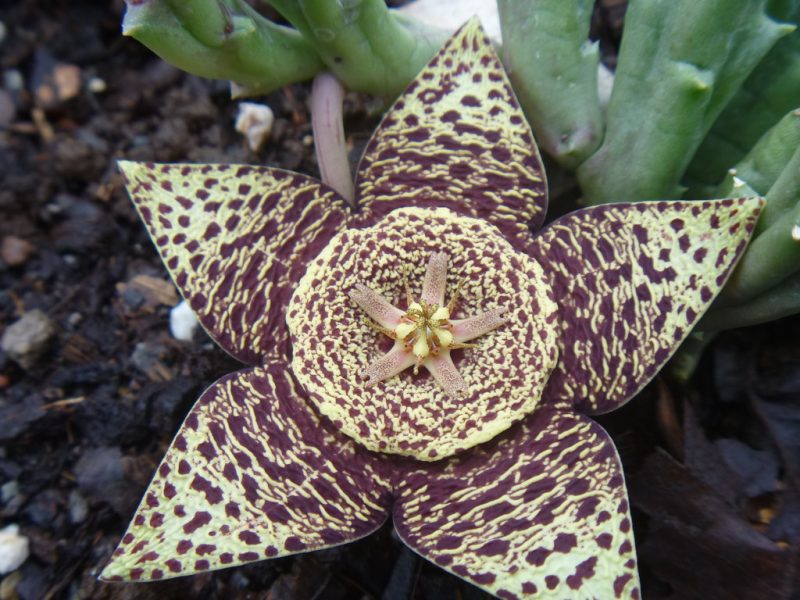
The Starfish Plant, scientifically known as Orbea variegata, is a captivating succulent that features large, star-shaped flowers that resemble the sea creature they are named after. Native to South Africa, this plant showcases thick, fleshy, green stems adorned with various textures and ridges that provide aesthetic interest.
Caring for the Starfish Plant requires providing bright sunlight and well-draining soil. Water the plant only when the soil completely dries out, as overwatering can lead to root rot. Interestingly, the flowers emit a foul odor, attracting pollinators such as flies and beetles, making it a fascinating species to observe. The charm of the Starfish Plant lies both in its unique flowers and its striking appearance, offering succulent enthusiasts a touch of drama.
Turkish Stonecrop (Rosularia platyphylla)

Turkish Stonecrop, or Rosularia platyphylla, is a delightful succulent native to Turkey, valued for its rosette formation and thick, flat leaves. The fleshy leaves exhibit a beautiful green color that may take on purple tints under stress, adding to its visual appeal. Turkish Stonecrop displays clusters of small, vibrant flowers in shades of pink or yellow, providing a lovely burst of color in the garden.
Caring for Turkish Stonecrop involves providing well-draining soil and bright, indirect light. This succulent is drought-tolerant and should be watered only when the soil has completely dried out. Its resilience and unique foliage shape make Turkish Stonecrop a wonderful addition to any succulent collection, whether used in rock gardens, containers, or as ground cover.
Graptoveria

Graptoveria is a hybrid genus known for its stunning rosettes, which combine characteristics of Graptopetalum and Echeveria. These succulents are characterized by their captivating colors, often featuring shades of blue, pink, and purple, which can vary depending on growing conditions and sunlight exposure. Graptoveria succulents are perfect for container gardens or as eye-catching focal points in any succulent arrangement.
Caring for Graptoveria generally involves providing bright, indirect sunlight and well-draining soil. These succulents prefer to dry out completely between waterings, making them suitable for low-maintenance gardeners. They may bloom colorful flowers during the growing season that emerge on tall stalks, providing a delightful floral display. The hybrid vigor and striking appearance of Graptoveria make it a sought-after choice among succulent enthusiasts.
Beads Lampranthus (Braunsia maximiliani)

Beads Lampranthus, scientifically known as Braunsia maximiliani, is a delightful succulent characterized by its small, bead-like leaves that create a lush, green cover. This charming plant produces colorful daisy-like flowers in vibrant hues, such as pink and orange, that bloom during the summer season. Native to South Africa, Beads Lampranthus is well-suited for sunny gardens and containers.
Caring for Beads Lampranthus involves providing plenty of sunlight and well-draining soil. Water only when the soil has completely dried out, as overwatering can harm the plant. Its stringy growth habit and cheerful flowering make this succulent a beautiful choice to bring color and life to any succulent garden.
Chinese Jade (Sinocrassula yunnanensis)
Chinese Jade, or Sinocrassula yunnanensis, is a charming succulent recognized for its shiny, jade-green leaves. This elegant plant forms a bushy appearance with thick, fleshy stems that can reach multiple feet, making it a delightful addition to indoor or outdoor spaces. Chinese Jade benefits from periodic pruning to encourage bushier growth and maintain its shape.
Caring for Chinese Jade involves providing bright, indirect light and well-draining soil. Allow the soil to dry thoroughly between waterings, as this succulent is sensitive to overwatering. Occasionally, it may produce tiny, white flowers that add an extra touch of beauty. With its serene appearance and easy care requirements, Chinese Jade is a beautiful addition to any succulent collection.
Mangave

Mangave is a captivating hybrid genus that results from crossing Agave and Manfreda plants, showcasing the best traits of both parent plants. These succulents are recognized for their incredible leaf patterns, colors, and varying textures that can range from smooth to heavily spotted. Mangave has quickly gained popularity among succulent enthusiasts for its unique appearance and hardy nature.
Caring for Mangave is relatively easy, as these plants prefer bright, indirect light and need well-draining soil. They enjoy minimal watering, allowing the soil to dry out completely between watering sessions. Many Mangave varieties produce tall spikes adorned with colorful flowers during the growing season, making them an eye-catching addition to any garden. The stunning aesthetics and adaptable nature of Mangave provide a delightful experience for plant lovers seeking a bold, impactful succulent.







